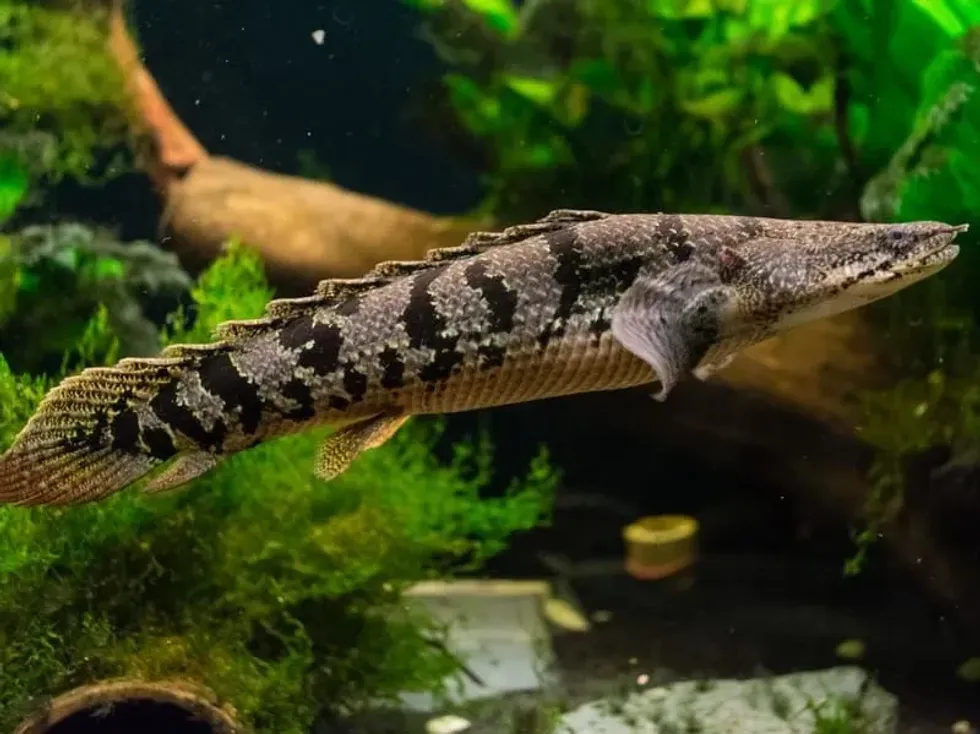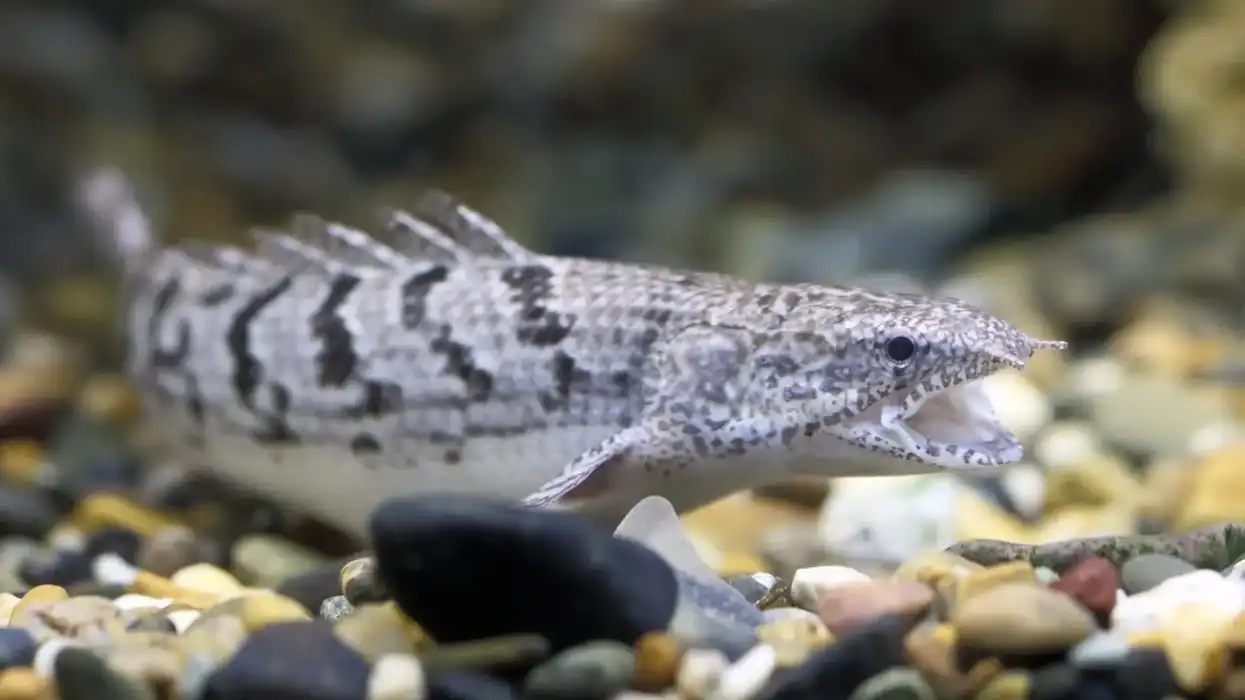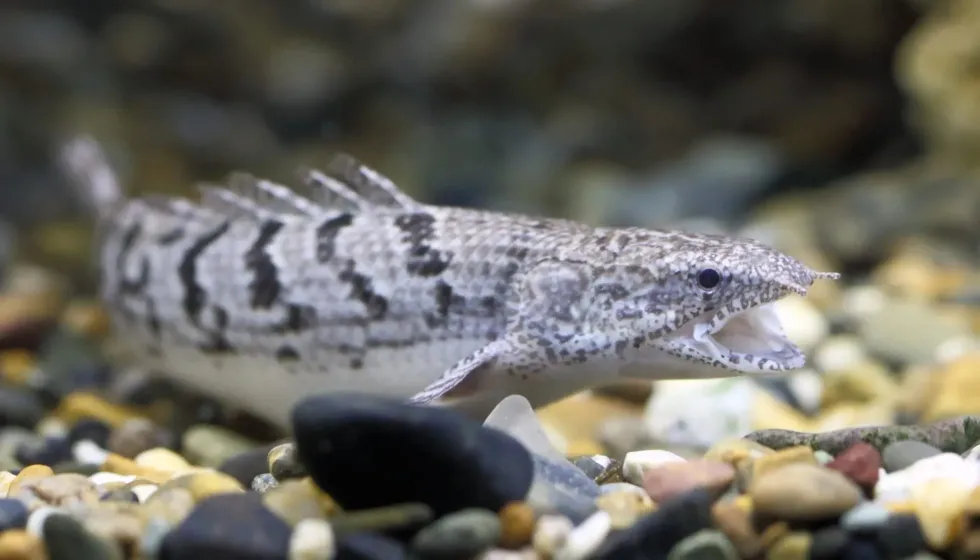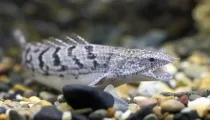Fun Barred Bichir Facts For Kids
Content
- What type of animal is a barred bichir?
- What class of animal does a barred bichir belong to?
- How many barred bichirs are there in the world?
- Where does a barred bichir live?
- What is a barred bichir's habitat?
- Who do barred bichirs live with?
- How long does a barred bichir live?
- How do they reproduce?
- What is their conservation status?
- What do barred bichirs look like?
- How cute are they?
- How do they communicate?
- How big is a barred bichir?
- How fast can a barred bichir swim?
- How much does a barred bichir weigh?
- What are the male and female names of the species?
- What would you call a baby barred bichir?
- What do they eat?
- Are they aggressive?
- Would they make a good pet?
- Did you know...
- How did the barred bichir get its name?
- What fish can live with a bichir?
The barred bichir (Polypterus delhezi) is a reptile-like fish, belonging to the Polypteridae family and the Polypterus genus. This fish is known for its body that resembles the combination between a snake and an eel. Bichirs are known as living fossils because of their appearance which is more like a prehistoric species of fish.
Barred bichirs and the rest of the bichir species have gained popularity as a great fish for a community tank and aquarium setup because of their slender look and nonchalant behavior as they crawl and swim around minding their own business.
If you want your fish tank to have a unique ecosystem then a bichir will certainly add to the variety as they can be the center of attention of your tank with their unique looks.
However, do remember to get a big tank size for your bichir so they have space to swim.
If you liked these facts about the barred bichir, then read our other articles about rainbow cichlid and royal gramma too!
Barred Bichir Interesting Facts
What type of animal is a barred bichir?
A barred bichir (Polypterus delhezi) is a species of ray-finned fishes that are found naturally in the freshwater parts of the Congo River. The bichir species also comprises the dinosaur bichir or the Senegal bichir, ornate bichir, saddled bichir, and the albino bichir.
These freshwater fishes have slowly made their way into the tank and aquarium setups of aquarists all around the world.
What class of animal does a barred bichir belong to?
These fish belong to the class of Actinopterygii as they are ray-finned fish. Actinopterygii is divided into two different classes Cladistia and Actinopteri. Actinopterygians comprise almost 30,000 species of fishes including piranhas.
How many barred bichirs are there in the world?
The exact population of the barred bichir species cannot be stated as these fishes can be found all across the world as they are famous aquarium fish. Due to their popularity, these fishes have seen a lot of breeding across the years which has only increased their population in the pet trade.
There is also a large natural population found in the Congo River basin.
Where does a barred bichir live?
Barred bichirs (Polypterus delhezi) were discovered in the Congo River and are found in the middle and upper portions of the river. These freshwater fishes are only found in the substrate in a small part of Central Africa.
Due to their rising popularity, they have gone through captive breeding and can now be found all across the world as a common aquarium fish species.
What is a barred bichir's habitat?
Barred bichirs are s fish species that can be found in a variety of water parameters and usually prefer habitats such as streams, quiet lakes, and fields with lots of aquatic plants and vegetation as they live in muddy parts of these areas.
They are nocturnal in nature and prefer dimly lit areas and spend their days in nooks, substrate, crannies, under rocks, and plants. These freshwater fish navigate these muddy waters in search of food using their good sense of smell.
They have poor eyesight due to the muddy waters surrounding them.
Who do barred bichirs live with?
Barred bichirs are a solitary species of fishes and prefer to live alone for the most part of their lifespan. They can be seen socializing during the breeding season. In an aquarium habitat, these fishes can be semi-aggressive so it is important to choose tank mates that can tolerate bichirs.
How long does a barred bichir live?
Not much is known about the lifespan of barred bichirs in the wild. In captivity, barred bichirs can live up to 10 years.
However, the lifespan of freshwater fish can be extended up to a maximum of 30 years if they are provided with exceptional care like feeding them a good food diet, proper care, and a large aquarium or tank size with lots of plants.
How do they reproduce?
Not much is known about the breeding procedure of this species of bichirs as most of them that you see in pet stores are taken directly from the wild and sold. In a tank or aquarium setup, these fish will seldom breed.
However, it has been seen that during the mating period the male pursues the female and will gently headbutt her. This entire procedure is a courting display and usually lasts two to three days.
If the female is receptive, she will let the male copulate with her. After fertilization, female bichirs will search for a safe place to lay eggs, usually preferring bushy plants.
What is their conservation status?
Currently, these ray-finned fishes are listed as a species of Least Concern on the IUCN Red List as their vast population across the world as a unique species of aquarium fish has added to their natural population.
Also, with the abundance of barred bichirs (Polypterus delhezi) found in the wild, this species is nowhere near the risk of a population decline or becoming endangered.
Barred Bichir Fun Facts
What do barred bichirs look like?
Barred bichirs are unique fish in their own regard as they are prehistoric fish who have been living with little to no evolution for more than 400 million years. The body of bichirs resembles a somewhat cross between an eel and a snake and they can grow quite long, in some cases, up to 39 in (99 cm).
Bichirs are living fossils that resemble ancient fish species as their lineages lead to the bony ray-finned fish we know today.
Barred bichirs have multiple dorsal fins and spines with nostrils that are easily visible and they use their pectoral fins to move which are shaped like a paddle.
The back of these bichirs has dorsal fins that are spiny which protects them from other carnivorous fishes.
The bone structure of bichirs is like that of sharks as they have a cartilaginous body and their mouth resembles the mouth of a salamander instead of a fish. The Polypterus genus, to which the barred bichirs belong, are the only vertebrates that are known to have lungs without the presence of a trachea.
Barred bichirs belong to the upper-jawed subclass of the Polypterus genus which means that their upper jaw protrudes farther out than the lower jaw.
Males and females can be differentiated according to their body size as females are slimmer and larger in size compared to males. Male bichirs have a thicker and wider anal and dorsal fin compared to the thinner and narrower anal and dorsal fin of female bichirs.

How cute are they?
Cute? Not so much. Unique?
Yes! These fish are unique as they have a slimy body which is the cross between a snake and an eel. They like to mind their own business feeding at the substrate of the tank or aquarium they live in and spend much of their time in search of food using their heightened sense of smell.
How do they communicate?
Not much is known about the communication methods of the barred bichir.
How big is a barred bichir?
The barred bichir (Polypterus delhezi) has a slender body that is elongated like that of an eel. These fish as full-grown adults grow up to 18.1 in (46 cm), which is the typical size for them in a community tank or aquarium setup.
It is larger than the dinosaur bichir and the saddled bichir, both of which grow up to 12 in (30.4 cm). The Senegal bichir grows up to 14 in (35.5 cm).
The barred bichir is smaller than the ornate bichir which is one of the largest bichir fish and grows up to 23.6 in (60 cm).
How fast can a barred bichir swim?
Not much is known about the speed at which these fish swim.
How much does a barred bichir weigh?
Due to a lack of sufficient data, the weight of a barred bichir is not known.
What are the male and female names of the species?
No particular name has been assigned to either sex of barred bichir fish.
What would you call a baby barred bichir?
A baby barred bichir has no specific name, however like with other baby fish, it can be called a fry.
Juvenile barred bichirs are delicate so special care should be provided and feeding should be done in the form of small size pellets that break up easily in the water. However, you have to be careful not to overfeed them as a bad diet can make them obese.
What do they eat?
Since the barred bichir (Polypterus delhezi) is a nocturnal fish, appropriate feeding should be provided according to the time they are active or inactive. You should be following their routine and not the other way around as disturbing them during their resting time might lead to them becoming groggy and inactive during their active hours.
Work with them instead of working against them.
Barred bichirs are slow eaters as they hunt during the night when most of their prey are inactive. Nighttime hunt for food is another feature that separates them from other fish species.
Barred bichirs are a carnivorous fish species so you will need to make sure their diet is made up of protein-rich food like frozen shrimps, ox heart, earthworm, nightcrawlers, and weather loaches. They can also be fed artificial food like flake food and pellets.
A mix of pellets and flake food, alongside live protein-rich food sources in their diet, is a great way to keep their predatory instincts alive and keep them healthy.
Are they aggressive?
Yes, barred bichirs are a semi-aggressive species of fish as they are predators. Due to this predatory behavior, fish that are smaller than your bichir should not be kept with them as tank mates.
Would they make a good pet?
Yes, a barred bichir can be an exceptional pet. However, barred bichirs are not for novice aquarists as this fish species can be very difficult to keep.
There are certain factors that you should keep in mind if and when you get a barred bichir. Some of which are as follows
1) These fish are a strong and healthy species and are bigger than average fishes in a community tank setup. In order to keep them, your Barred bichir tank size should be at the very least 50 gal (189.2 L). The larger, the better!
2) Since these fish are reptile-like creatures and often move like them, it is advised to keep a lid on your tank at all times as they might crawl or jump out of the tank.
3) Since bichirs have lungs, they need air to breathe, so it is recommended that if your tank does not have enough surface water movement area, then an air pump is necessary. Keeping an emergency air pump is also recommended in case the one in use stops working.
4) These fish, even with their hardy build, need proper water parameters to survive normally. The water acidity pH should always be kept at about seven as they do not require hard water and can be comfortable in both hard and soft water.
However, it is better to keep the level at a mild range and not go for extremely hard water, such as a pH value above 20.
5) Bichirs are bottom feeders, meaning that you have to make a thin layer of sand, gravel, and other small dusty materials at the bottom of the tank for them to hide and feed on which replicates their natural habitats. Decorations are optional, as aquarists, in order to decrease the territory dependence of these fish.
It is recommended keeping them in an empty tank, however, it can be a bit depressing seeing them all alone with no plants or decorations around them in their tank setup.
It is up to you if you want decorations or not. Some tank decorations, in case you use them, are stones, caves, small castles, and small tank plants.
Did you know...
Bichirs are mostly blind and deaf in nature due to the muddy habitat they live in and hunt using their heightened sense of smell.
As of now, there are 12 living bichir species, all of which are found in Africa. Out of the 12, 11 are called bichirs and one is called a reedfish.
Congo bichirs can grow up to 38.1 in (96.7 cm) and weigh as much as 9.7 lb (4.4 kg), which is a lot for a tank fish.
Bichirs, thanks to their lungs, can survive outside water for a good amount of time, given their skin remains moist.
The bichir species is one of the oldest fish that can be found today as they date back to almost 400 million years old.
How did the barred bichir get its name?
The barred bichir belongs to the Polypteriformes order and the Polypteridae family. The name comes from the Greek words 'poly' and 'pteron' which means 'lots of' and 'fins' respectively. This name focuses on the high number of dorsal finlets in place of normal dorsal fins.
The barred bichir is also known as the armoured bichir or the banded bichir.
What fish can live with a bichir?
Due to the barred bichir being a predatory species of fish, their tank mates should never be fish smaller than them as they will prey on them. Instead, they should be kept with tank mates that are larger than them.
Some of the fishes that can be kept with barred bichirs are oscar fish, flowerhorn cichlids, African knife, clown loaches, Jack Dempsey fish, and silver dollar fish.
Here at Kidadl, we have carefully created lots of interesting family-friendly animal facts for everyone to discover! Learn more about some other fish from our Mandarinfish and Atlantic bonito pages.
You can even occupy yourself at home by coloring in one of our free printable barred bichir coloring pages.
We Want Your Photos!
More for You
See All
Bachelor of Arts specializing in Journalism and Mass Communication, Postgraduate Diploma in Sports Management

Moumita DuttaBachelor of Arts specializing in Journalism and Mass Communication, Postgraduate Diploma in Sports Management
A content writer and editor with a passion for sports, Moumita has honed her skills in producing compelling match reports and stories about sporting heroes. She holds a degree in Journalism and Mass Communication from the Indian Institute of Social Welfare and Business Management, Calcutta University, alongside a postgraduate diploma in Sports Management.
Disclaimer
1) Kidadl is independent and to make our service free to you the reader we are supported by advertising. We hope you love our recommendations for products and services! What we suggest is selected independently by the Kidadl team. If you purchase using the Buy Now button we may earn a small commission. This does not influence our choices. Prices are correct and items are available at the time the article was published but we cannot guarantee that on the time of reading. Please note that Kidadl is a participant in the Amazon Services LLC Associates Program, an affiliate advertising program designed to provide a means for sites to earn advertising fees by advertising and linking to Amazon. We also link to other websites, but are not responsible for their content.
2) At Kidadl, we strive to recommend the very best activities and events. We will always aim to give you accurate information at the date of publication - however, information does change, so it’s important you do your own research, double-check and make the decision that is right for your family. We recognise that not all activities and ideas are appropriate for all children and families or in all circumstances. Our recommended activities are based on age but these are a guide. We recommend that these ideas are used as inspiration, that ideas are undertaken with appropriate adult supervision, and that each adult uses their own discretion and knowledge of their children to consider the safety and suitability. Kidadl cannot accept liability for the execution of these ideas, and parental supervision is advised at all times, as safety is paramount. Anyone using the information provided by Kidadl does so at their own risk and we can not accept liability if things go wrong.
3) Because we are an educational resource, we have quotes and facts about a range of historical and modern figures. We do not endorse the actions of or rhetoric of all the people included in these collections, but we think they are important for growing minds to learn about under the guidance of parents or guardians.







